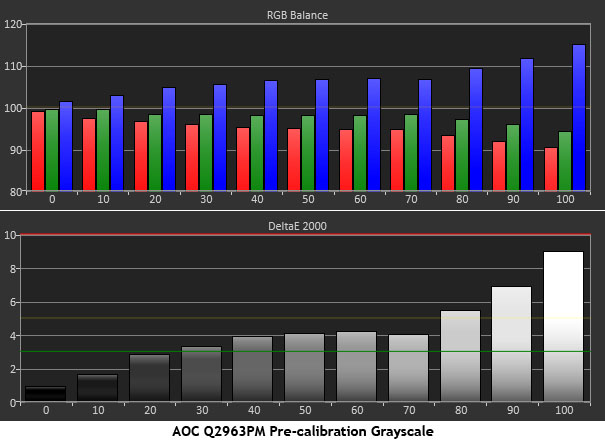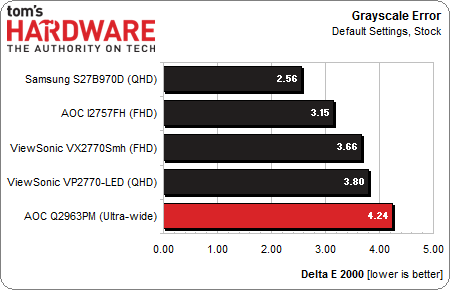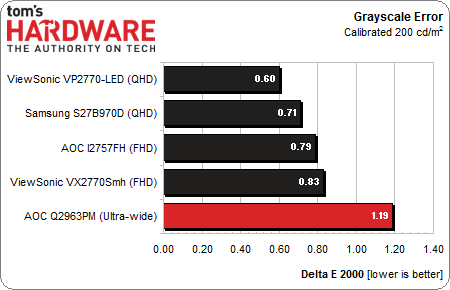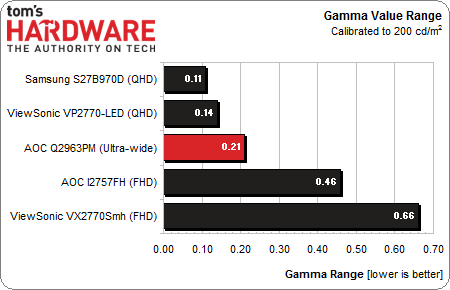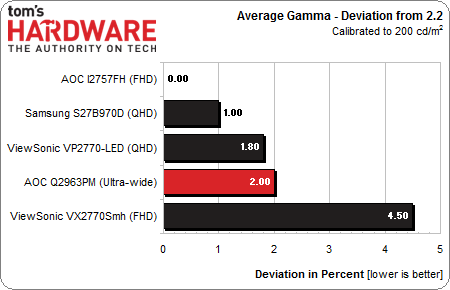AOC Q2963PM Monitor Review: 2560x1080 Is A New Way To Play
2560x1080 is an unusual resolution for a computer monitor. Does it change the way we work? We spent some time with AOC's new Q2963PM to find out. With some unique features on-board, we're more than curious to see what makes this radical new display tick.
Results: Grayscale Tracking And Gamma Response
The majority of monitors, especially newer models, display excellent grayscale tracking (even at stock settings). It’s important that the color of white be consistently neutral at all light levels from darkest to brightest. Grayscale performance impacts color accuracy with regard to the secondary colors: cyan, magenta, and yellow. Since computer monitors typically have no color or tint adjustment, accurate grayscale is key.
The Q2963PM’s out-of-box grayscale rides a little blue at the default Warm color temp preset. This option is closer to the correct 6500K than the other presets, but represents an average Delta E error of 4.24. Since a Delta E value of three crosses the visible threshold, we're getting a little blue tint to white content (a tint that increases with the brightness level).
Fortunately, this is easily fixed in the User color temp mode.
This is an excellent measurement run, except for the 100 percent signal level, which is still too blue. You can fix this by lowering the Contrast control, though you drop the max luminance level below 200 cd/m2 in the process. Practically, the error is almost never visible because real content rarely reaches a full 100 percent output level. You might see the blue tint if you watch a hockey game, for example, but we couldn’t see any problem in either productivity or gaming applications.
You can see that neither a monitor’s resolution, nor its price tag affects its grayscale performance.
The AOC’s stock grayscale error, while not overly grievous, is below average compared to the majority of other monitors. This is the only metric that comes up a little short, in our opinion.
But let’s see how things stack up after calibration:
Get Tom's Hardware's best news and in-depth reviews, straight to your inbox.
Don’t let this chart fool you into thinking the AOC is a poor performer. An average Delta E error of 1.19 is still quite imperceptible. And this number is affected by the 100 percent measurement. The rest of the luminance range is nearly perfect. In fact, if the 100 percent value were removed, the Q2963PM’s average would be .83 Delta E, tying with ViewSonic's VX2770Smh.
Gamma Response
Gamma is the measurement of luminance levels at every step in the brightness range from 0 to 100 percent. This is important because poor gamma can either crush detail at various points or wash it out, making the entire picture appear flat and dull. Correct gamma produces a more three-dimensional image, with a greater sense of depth and realism. Meanwhile, incorrect gamma can negatively affect image quality, even in monitors with high contrast ratios.
In the gamma charts below, the yellow line represents 2.2, which is the most widely accepted standard for television, film, and computer graphics production. The closer the white measurement trace comes to 2.2, the better.
The last AOC screen we reviewed, the I2757FH, also showed excellent gamma response. We are glad to see AOC’s attention to detail on this very important metric. The Q2963PM showed only tiny bumps at 20, 80, and 90 percent. When the trace is above the yellow line, it means that the signal level is too dark (around seven percent too dark in this case).
Here are the gamma numbers put up against the same group of monitors.
With a span of only .21, the AOC is looks pretty good, and is only outdistanced by two much more expensive QHD screens. This means its gamma response is fairly flat from the darkest to lightest signals.
We calculate gamma deviation by simply expressing the difference from 2.2 as a percentage.
The I2757FH we tested back in January is still the only display to measure a perfect 2.2 for average gamma. The Q2963PM is only slightly behind at two percent. Any display that comes within 10 percent of the standard is showing solid gamma performance.
Current page: Results: Grayscale Tracking And Gamma Response
Prev Page Results: Brightness And Contrast Next Page Results: Color Gamut And Performance
Christian Eberle is a Contributing Editor for Tom's Hardware US. He's a veteran reviewer of A/V equipment, specializing in monitors. Christian began his obsession with tech when he built his first PC in 1991, a 286 running DOS 3.0 at a blazing 12MHz. In 2006, he undertook training from the Imaging Science Foundation in video calibration and testing and thus started a passion for precise imaging that persists to this day. He is also a professional musician with a degree from the New England Conservatory as a classical bassoonist which he used to good effect as a performer with the West Point Army Band from 1987 to 2013. He enjoys watching movies and listening to high-end audio in his custom-built home theater and can be seen riding trails near his home on a race-ready ICE VTX recumbent trike. Christian enjoys the endless summer in Florida where he lives with his wife and Chihuahua and plays with orchestras around the state.
-
Simos Kozanidis Does it tilt?Reply
Having 2 in chain of those, tilted on the side, would be very nice for productivity apps, like coding, etc. -
eddieroolz Good to see 21:9 monitors come down in price. I don't ever watch movies so the width is no use for me, though what I'd like to see in the future is a vertical VESA mount to stack 2 of these monitors in the vertical orientation. That would result in a 2560x2160 resolution that would be great for productivity purposes.Reply -
giovanni86 I'm actually in the market for the LG 21:9 primarily for gaming. Though i was disappointed that the veritcal length is smaller then others. Its still a very nice display. Looking forward to buying it and playing BF4 on it :)Reply -
ubercake Seems like a good choice for an RTS/MMORPGer. The input lag of the IPS panel is still going to keep me away from using something like this for shooters.Reply -
vertexx With the multiple sources, does it force a 50-50 split or is that adjustable?Reply
I currently run two PCs for my daily work and could probably use something like this. Two 1080p monitors side by side is too much back and forth, so this may be a good solution. But I'd want to be able to adjust the split between the sources if needed.
Thanks! -
cknobman I know no one wants to hear this and I will be instantly down voted but this resolution seems ideal for Windows 8 Metro/Modern interface.Reply
Everything in Windows 8 Metro/Modern is designed for horizontal screen orientation vs. vertical.
Besides that point this monitor seems like a great piece of hardware for the money. Nice review! -
major-error Reply
What you're looking for comes from Ergotron: http://www.ergotron.com/ProductsDetails/tabid/65/PRDID/15/language/en-US/Default.aspx11424113 said:Good to see 21:9 monitors come down in price. I don't ever watch movies so the width is no use for me, though what I'd like to see in the future is a vertical VESA mount to stack 2 of these monitors in the vertical orientation. That would result in a 2560x2160 resolution that would be great for productivity purposes.
I have this stand holding up a pair of Dell U2412M displays. My only real concern when hanging displays on this stand is the panel weight, although I bet the bottom-mounted of a pair of 27" 16:9 displays would end up touching the desk... -
nekromobo You totally forgot to compare it to Dell U2913WM for little more there's 3years NBD warranty etc.. not to mention how does it compare picture-wise? Probably same panel used on both.Reply
